|
|
|


Abstracts
Thanks to Hannah Lefeuvre
for notes on various of the presentations, included below.
- Diane Amans
(Notes by Hannah Lefeuvre)
• What is important? What is likely to lead to a positive experience?
• Playfulness – Liberman (Educationalist) says that a truly
playful person has a rich resource of coping strategies and that playful
encounters are important in all aspects of life.
• Wellbeing and dementia is about being able to engage with people.
Our own inner child is open and free. Confident and at ease. Spontaneous
and immediate.
• Lures to invite people to respond: a giant balloon – clocking
reactions, Occupational Therapist played the violin and they moved together,
Rock and roll music
• Partner dancing is ideal
• Non-verbal communication works well – verbal directions
can cause anxiety.
• Author Oliver James talks about feeling good and not knowing
why
- Francis
Angol
‘Body Stories’ – memories of our lives
Body Stories is a physical metaphor for lifestyle changes, celebrating
the presence of self through a triangulated dialogue of rhythm, movement
and cognitive awareness set within framework that embraces wisdom
and life long enriching experiences. Choreographed by Francis
Angol.
- Sue Benson
- Jagjit Chuhan
Art and Dementia
Jagjit Chuhan will consider aspects of how the making and appreciation
of visual art, without recourse to verbal language, enables conscious
thought, offering valuable insights into the experiences and the cultural
and social environment of the artist. Whilst this is true of any artist,
she will explore how creatively engaging with the visual and performing
arts provides opportunities for people with dementia to express themselves
and to access long or short term memories, emotions, self-exploration,
thoughts, dreams and hopes. Creative activities engage areas of the
brain that are not damaged by the disease and thus reawaken a sense
of personality, identity and dignity, and may even improve mobility,
speech and quality of life. This non-pharmaceutical approach helps alleviate
anxiety and confusion and provide some respite for people with dementia
and their caregivers. She will consider how this has been successfully
achieved in numerous projects such as those at the Museum of Modern
Art in New York. A further aspect of art and dementia is the problematic
potential for studying changing characteristics in art production as
a means of early diagnosis and treatment, in the context of art history
and the effects on art production of the artists’ personality
and of art conventions and styles, looking at the aesthetics of art
movements such as surrealism, and the work of artists such as Willem
de Kooning.
- Julia Clark
Tapping into embodied neurological rhythm with music and dance
therapies
Julia has been privileged to work alongside Artists and Musicians
in a variety of rehabilitation settings. It was the therapeutic effectiveness
of the arts that prompted her to consider the scientific evidence
of the neuropsychological underpinnings to this success. Her paper
looks at the parallel neurological development of movement, musicality
and the emotions.
Music and dance have long been known to aid meditation, raise mood
and improve heath but in addition to this Julia will discuss the successful
use of music as a targeted therapeutic tool in people with impairment
of the movement pathways in the brain. Taking evidence from the field
of amputation and prosthesis she will also discuss the role of dance
as a means of restoring a feeling of wholeness to those whose lives
are restricted by neurological conditions of whatever type.
(Notes by Hannah Lefeuvre) A highlight of the conference.
Julia gave neuroscientific evidence of the value of dance and music
for dementia. It was a very dense presentation. Notes from her presentation
are listed below, kept in note form, for clarity.
• Everyone is different - we each have a different genetic
cross-wiring in the brain, therefore each dementia is different. This
gives justification for the single case-study approach. The arts can
tap into this
• Julia’s case study had Locked-in Syndrome* at 22 yrs
old. She was intellectually intact, but couldn’t move, except
her eyes. The person is there. Can happen after a trauma or stroke.
A 1 year into the condition, the patient could swallow and breath
independently. As the years went by, Julia observed the patient degenerate
rapidly.
* A journalist had Locked-in syndrome recently and documented it.
If we go back to medical routes, we can trace it to 1907. Sub-cortal
dementias affect parts of the brain controlling movement, e.g. Parkinsons,
Huntingtons, Motor Neurones. Facial and emotional expression decreased.
The cause of damage is not important, it’s where it is. Starter
motor in brain initiates movement. Loss of brain’s piper rhythm
in Locked-in – unable to initiate movement.
Evolution and use of music
Music therapy can be used to enhance mood. People may forget what
you say, but not how you make them feel. Many types of memory. Examples
of rhythm in nature / everyday lives include:
• Migration, eco-location – e.g. bees, swallows, bats,
pod of whales
• Military cadence – override emotion through rhythm and
song. Energises, motivates, improves posture.
• Rocking child, courtship, ecstasy, anger, battle chant
• Rugby Haka
Music and movement share pathways. Isabel Curran 2006 – A regular
musical beat can be used to replace the piper rhythm – internal
rhythms synchronise and muscles respond to the beat of the music.
For example, clapping – possibly heart beat.
Mozart effect
• Causes dophamine and serotonin to be secreted – diminished
in movement disorders
• Improves space-time reasoning
• The heart is a muscle, therefore it can respond to the music
• Calm music- increases the production of hormone Oxytocin –
the love hormone and reverses the effect of stress hormones
• If Mozart is played during surgery, has been found to resulted
in a better recovery
General notes
• Classical Indian music slows breathing and heart rate.
• Music preference is less effective than pace.
• Repetitive sound meditation – repetitive ohm and keeping
very still has been found to be beneficial. FMRI scan of meditation
shows up a focused attention, increased attention to frontal lobe
• Props – extend your movement and sense of life and self
(amputated self)
• Brain feedback loops – moving, facial muscle –
smile. Milliseconds to change mood – when hear happy music –
changed facial expression
• Non-parametric and parametric tests – I need to look
this one up, as I got a bit confused.
- Dr
Richard Coaten
Goulash, well-stirred
Theme: After giving it this title without much thought I have discovered
the following. The root of the word goulash refers to a shepherd in
Hungarian 'Goulyas' and the link to his food, a stew made with beef
or veal including vegetables & seasoned with paprika ( hot &
spicy). The root of the word 'stir' is to 'rouse from dormancy', to
begin to come to life, to excite feeling, involving or provoking insight.
'To make a liquid move with an agitated motion so the particles change
position'. I am thinking about the agitation of dementia, things mixing
together and mixture as confusion....coupled with the idea of transforming
the everyday and revealing insight in the process. I am symbolically
aiming to stir the pot of body language and to include the idea that
wherever there is a 'dementing' process there is also by way of Jung's
idea of the 'compensatory function' an equal an opposite attempt by
the body to maintain equilibrium and in effect to 'rement' whether
or not we are consciously or non-consciously aware of that taking
place in ourselves or in others.
Duration: 20-25 minutes
Purpose: as expressed above its purpose is to embody and posit through
the dance that wherever 'dementing' is taking place, there is also
at some level and in some way, a 'rementing' going on, or an attempt
by the organism to maintain a homeostasis in spite of what may be
deep and on-going neurological deterioration. It is formulated also
on personal and professional experience in the field for the past
25 years and the notion that 'Personhood' is not lost in spite of
severe and enduring mental deterioration. One's fundamental identity
still exists and it is the responsibility of those around us never
to lose sight of this fact and to find varied and creative ways of
being able to reach the person.
(Notes by Hannah Lefeuvre) Richard Coaten was a memorable
speaker, who’s paper was rooted in the idea that whilst cognitive
function is diminished, emotional intelligence is not. He talked about
the importance of being in the moment and being emotionally open.
Holding a “high quality, free-floating attention”, supporting
identity and personhood. Dementia strips us away to our essence, it
is an expression of humanity. We are building bridges of understanding,
through the lived body. For example, we are building bridges between:
- Physco – Soma
- Sense – non-sense
- Known – not yet known
- Thinking – feeling
- Meaningless – meaningful
The meeting place is about relationships.
Richard highlighted the Dance Movement Therapy skills that come into
play in this work, including:
• Locating triggers – ways in
• Mirroring – reciprocity – same height / can you
accept difference in otherness?
• Rhythm – neuroscience gives us evidence that rhythm
helps organise principles in our brains
• Music, song and percussion
• Importance of repetition
• Re-membering
• Working through metaphor and symbolism
He also stressed the important of working in pairs, rather than solo
and the need to plan, debrief and prepare well.
Richard referred to the conference image, of two hands, to provoke
an improvisation, by delegates, of one hand dementing, the other supporting.
He linked this to Yung’s theory on compensatory function, ie,
that when one element of the body dements, another compensates. He
talked about our role as supporters / enablers within these two hands.
Richard spoke of a subjective embodied experience and how through
dance, participants can go from a place of low well-being, anxiety
and depression, to a lovely sense of positive wellbeing and the brain
being at rest.
He spoke of “creative alertness”, “poetic awareness”
and called the work “embodied, phenomenological and psychological”
He saw the work as remedial rather than curatorial and drew a parallel
between the improvisatory nature of dance and that of a person’s
response to their condition.
- Fergus
Early
(Notes by Hannah Lefeuvre) Observations
• One to one work is ideal - picking up on signals
• Multi-sensory input - touch, words, putting elements together
• Cultural appropriateness – research people’s backgrounds
– triggers
• Sometimes the work can bypass the diagnosis
• Greater attention span in dance
- Heather Edington
- Alicia Sofia Garfias
Dancing with Loss: Dance Movement Psychotherapy for Older Persons with
Dementia
Loss in a Dance Movement Psychotherapy (DMP) group with older persons
with dementia is experienced on many levels. Both the client and therapist
feel it. Fear of loss may touch our deepest fears and force us to
observe issues that could have been long neglected.
My work focuses on an exploration of loss that occurred in a therapeutic
relationship with a group of older persons diagnosed with dementia.
I describe my practice as a DMP through a review of literature in
psychodynamic psychotherapy, DMP, and dementia care; describe a movement
exploration; and in-depth discussion of case material.
The theme of loss in clients with dementia is explored through Evidence-Based
Practice and research in relation to DMP and case material in the
context of therapy within a Day Hospital. Common losses within the
group are identified, including the painful experience of the loss
of a group member. I describe the process of therapy over time through
clinical examples of interactions and interventions that occurred
as part of the interrelationship between clients, therapist and dance
movement, while making use of the boundaries of therapeutic space.
I discuss the ending, projection and assessment of the work including
its limitations, bringing together ideas from psychodynamic psychotherapy
processes emerging from the clinical work and literature reviewed
on the theme of loss, DMP and older persons with dementia.
See a PDF file of her presentation here.
- GODS - Growing Older (Dis)gracefully
La Cosa Claras el Chocolate Espeso
Choreography: Linda Clough
Music: Sam Ferry
This piece has as its starting point the contribution that eating
chocolate can make to stress reduction. More importantly as we dance
we have fun, we share this fun with our audiences, we are very active
in our enjoyment of rhythmic movement, and we lean on, support and
lift each other. All these are factors which help us, and others,
to alleviate the strains of everyday living.
We have been very fortunate that in 2010 we have both received funding
from Liverpool City Council and the PCT, and benefitted from ongoing
support for Liverpool John Moores University Dance Department.
- Azucena
Guzman
Azucena cannot put her talk on-line for research ethical reasons,
but you can obtain references, publications and Danzón music
by emailing her.
(Notes by Hannah Lefeuvre) Azucena talked about her research
in Psychomotor dance, using Dazon music and dance. Her research is interested
in non-pharmological interventions (such as dance) before pharmological.
Although this was an incredibly engaging presentation, grounded in sound
academic research, I took few notes. I have requested a copy of her
slides (azucena.guzman@newcastle.ac.uk). I will forward these on when
I receive them.
- Dr Jill Hayes
Dance and Dementia in a Creative Arts Training Project
This lecture will focus on a Skills for Care dementia research project
which took place in East and West Sussex in 2007-2008. The action
research case study involved three arts professionals in training
dementia care staff in the formation of relationship through the arts
modalities of dance, singing and arts activities. The focus of the
training was the awakening of sensory receptivity and expression,
perceived as a key to relationship and hence communication in dementia.
Staff at 7 care homes were introduced to dance, singing and imaginative
improvisation which they then put into practice with their service
users. Amongst the discoveries of this action research was the important
finding that staff felt deeply seen and acknowledged by one another
and as a consequence of this experience felt motivated to spend time
being with service users through embodied presence both in arts based
activities and in the general daily routine in the home.
- David Howe
Forget Me Not - To what extent does the individual occupy the
role of the person with dementia?
David Howe, Drama and Movement therapist, presents a short talk on the
benefits of using film in therapy as an aid to remembering and personal
change in the everyday . The talk will focus on 6 filmed dramatherapy
sessions with a mixed group, aged between 80-90 years, in a specialised
daycare setting for clients with varying degrees of dementia. Using
a brief filmed extract patterns of movement and group reflection across
sessions will be discussed. Jungian perspectives on ‘unconscious
memory’ and its role in strengthening the individual will also
be mentioned.
- Teresa Jankowska Liverpool
PTC
National Dementia Strategy
Teresa spoke of Liverpool’s approach of moving away from the medical
model of the Doctor being the expert, of acknowledging the individual,
who know their own stories best, and listening to these stories.
She talked about Liverpool’s commitment to workforce development
and training (including consultants and therapists) and gaining an increased
understanding of Dementia. She cited examples of identified quality
outcomes, such as ‘a person has the right to contribute to society,
even in later, demented years’. She recognised the ‘bringing
into contact’ that occurs as we come closer to death.
- Kath Kershaw with Cynthia
Heymanson
Come and discover the potential of Circle Dancing when working with
people with memory loss, and learn the skills to provide an activity
with therapeutic benefits for people with dementia.
Dance and Movement have successfully been included in activities
for people with dementia for many years. Making use of rhythm, music,
touch and movement, for people who experience difficulties with communication
and loss of confidence has been evidenced as promoting their well-being.
500 staff from Day Centres, Care Homes, Support Groups, PCTs have
attended training workshops since September 2008; their positive feedback
endorse the benefits of this activity.
What is Circle Dancing?
Circle Dancing has developed from traditional folk dance from around
the world and there is a network of groups in the UK. Circle Dance
emphasises relationships, group belonging, emotional and physical
aspects of being.
How can it work for People with Dementia?
Dances from the repertoire have been adapted and simplified, and can
be done both seated and standing. The features of being in a group,
holding, touching, swaying, promotes re-attachment, relationships
and stimulation – all help retain the sense of personhood. The
activity can be used at relatives’ events. The cultural range
of dances can re-link users, participating staff and carers with their
cultures.
The circle dance demonstrated during the conference used Sydney
Carter's song "Julian
of Norwich" available on a CD of Sydney Carter songs (some
sung by him) here
for example.
- John
Killick
(Notes by Hannah Lefeuvre) John Killick read several
poems that had been written by people with dementia and emphasised the
creative urges and talents of those he had worked with. As he read these
poems, including one about “floating in the sky, high up above
the clouds” and “young people don’t see true beauty”
I felt as though the voices were those of people that had drifted into
a profound place, where the mind starts to shut down on the day-to-day
practicalities and stresses of life and move into a spiritual awareness.
I wondered if there was any research that might correlate the level
of stress / creative outlets against the likelihood of getting dementia.
For example, if a person experiences less stress, is creatively and
spiritually fulfilled in childhood and adulthood, are they less likely
to ‘dement’ and is dementia a degenerative condition or
a regenerative condition? A moving back to what is important, coming
full circle – more in touch with one’s spirituality and
a profound thinking, in preparation for death / another life? Experiencing
rich South Asian dance in Liverpool, I was reminded of what this culture
and philosophy can offer to our perspective on dance in later years.
“It’s a licence to be free to be me...I think when I got
the diagnosis...I wanted to find out if I was artistic. Being able to
think outside of the box. It’s a nice feeling.”
“I’d rather be a creature of the air than the earth.”
“Why cry when you can laugh? It doesn’t cost anything”
Killick spoke of his dream – a work with dementia to include contributions
and collaborations from all art forms.
References:
• “I’m still here” (Book) – the gifts
of alzeimers
• www.dementiapositive.com (John Killick and Kate Allen)
• John referred to Tom Kitwood and Faith Gibson, who talks about
how dementia strips people down. Frees them to be creative. Communicate
with greater authenticity.
- Yael
Loewenstein
Voice of Change
Yael Loewenstein will present observations, thoughts and considerations
as she continues to develop her project Voices of Change. (Supported
by Chisenhale Dance Space and The London Borough of Tower Hamlets)
Voices of Change is a community project that involves fitness/dance
sessions in local care homes and drop in centres. The sessions aim
to offer an opportunity for participants to dance together and express
their history in the community and related points of view. The project
is currently in a second phase that is being rolled out to approximately
60 participants.
Drawing together her work as a choreographer, dancer, falls prevention
practitioner and fitness/movement practitioner, Yael will discuss
outcomes of the project for groups and individuals. Effects and responses
to this developing programme, particularly in terms of memory and
working with a range of participants including many with early stages
of dementia, will be presented.
To view a short film produced in 2009 during phase I of Voices of
Change please follow either of these links.
http://www.youtube.com/watch?v=avGuYTY1VLQ
http://www.myspace.com/index.cfm?fuseaction=vids.individual&videoId=100532123
- Sissy
Lykou
Learning Disabilities and Dementia
The combination of learning disabilities and dementia hides quite many
risks in the sense of frequently missing or misinterpreting the early
stages of the latter. A person with learning disabilities finds it difficult
to express him/herself and dementia deteriorates this state of expression.
With this paper I will try to briefly explain the targets and expectations
of the therapeutic interventions when working with such clients in care
homes.
Although the main focus in the learning disabilities services is on
enabling people’s growth and development of their full potential,
when dementia is also diagnosed, then the maintenance of skills, abilities
and interests should be the main target. In this way we do not only
sustain a better quality of life for the client, but we also try to
move with their pace without making the environment more stressful and
frightening; feelings experienced due to the dissociation with the here
and now.
Positively relaxing interventions, failure-free activities, reminiscence
work and the arts can be the tools for understanding the motivation
and meaning that informs our clients’ behaviour (Kerr, 2007).
The theories and researches described in this paper will be illustrated
by a case study of a woman aged 62 with mild learning disabilities and
psychosis, resident of a care home for people with learning disabilities
and mental health problems, who attended dance movement psychotherapy
(DMP) sessions for ten months; the DMP input was provided before and
after her diagnosis of dementia.
- Mantra
Lingua
Mantra Lingua is a UK based publishing house that supplies bilingual
resources around the world.
The products connect with and transcend national differences in a
way that is respectful and appreciative of local cultures. The name
Mantra Lingua is an amalgam between the Sanskrit and Latin, but Mantra
also covers the Far Eastern and the African continents.
Mantra Lingua is about connecting languages for children. With increased
mobility of populations across the globe, e.g. Brazilians in Japan,
Germans in Sweden, Indians in Gambia, Mantra Lingua has developed
a set of values that stems from a desire to retain distinctness and
yet encourage integration of new communities in various societies.
Mantra Lingua's values are as follows:
* To celebrate the cultural and linguistic nature of society and
to establish a culture of tolerance and awareness in young people,
both from the host and the new communities.
* To provide resources for ethnic minority groups with strong central
characters and community settings, to help build the child's self
esteem and social interaction.
* To share across cultures the children's books that are special -
taking best selling well-known books and publishing them in as many
languages as possible.
* To provide teachers and librarians with creative resource materials,
which are inclusive of all the community and are not dominated by
one single culture.
* To strive for innovation and creativity in learning methods, promoting
the values of bilingualism not only to enhance language skills but
also in the learning of the major national language.
* To increase the awareness of the diversity of cultures and the enriching
prospects for more cross-cultural activities and resources. Together
these will make for a more global understanding of the nature and
nuances of peoples from different countries or communities.
- François
Matarasso
(Notes by Hannah Lefeuvre) Francois Matarraso opened day two
with his reflections on the conference so far, drawing parallels between
his impression of the work on day one and his interaction with his son
in his early, pre-verbal years. Francois acknowledged Community Dancers’
sensitivity and their ability to say the unsaid. Whilst Art is always
about relationships, he felt that it was more than that in this context
– about a communion – a shared commitment and values. He
referred to Richard Coaten’s term, re-membering, of being a member
of a community again: that’s what remembering is. He talked about
being present in the moment, and a present being a gift that the practice
brings.
- Clive
Parkinson
On Fortuitous Novelties
This presentation will explore the personal and professional
impact of dementia within Clive’s own family and will take in
popular culture, the arts and design to understand the potential of
human flourishing whilst living with dementia, exploring current collaboration
Clive Parkinson is a facilitator and educator with experience that
spans the statutory and voluntary sectors. He has written and presented
widely around the arts and health agenda sharing his hands-on experience
as a practicing artist and his strategic understanding of the field
through research and development. He has worked for the National Heath
Service as an artist in a hospital for adults with learning difficulties
and as a senior mental health promotion specialist; and within the
cultural sector was development director for Arts for Health Cornwall.
As current Director of Arts for Health at Manchester Metropolitan
University his work focuses less on the built environment, ill-health
and deficit, and more on public health, well-being and community assets.
He is currently working with the Asia Europe Foundation on multi-sector
pandemic planning and response, and is keen to bridge the arts and
public health sectors. www.artsforhealth.org
http://artsforhealthmmu.blogspot.com
On Fortuitous Novelties
(Notes by Hannah Lefeuvre) Clive, a designer, spoke about
Art, design and sentience and his work with an artist Darren Browett,
creating objects to take into homes. He spoke of how the objects had
provoked conversations, which were beyond just reminiscence work.
These carefully crafted objects were loaded with meaning. He talked
of his own experience with his grandmother and her requests to constantly
come home and his own observations of increased disinhibition, giving
powerful opportunity for creativity.
I loved the tidiness of his work. So much was encompassed in these
smooth, clean, wonderfully crafted objects. Giving opportunity to
sit and wonder, stare, touch and share.
Cohen “arts is like chocolate for the brain. Focuses on assets
and the person. Art allows us to explore taboo ideas e.g. decay and
death, sexuality and mistakes.”
http://darrenbrowett.wordpress.com
http://moma.org/meetme
- Marina
Rova
De Mentis: Silent Stories I, II and III [Dedicated to Derek
Malcolm Hamilton Barns]
Artistic Direction & Choreography: Marina Rova
Music : Greg Vamvakas
Perforrmance: D. Bilon, E. Kolyra, G. Tsagdis, H. Pickett, N. Colbert,
B. Naso, D. Prismantaite, V. Pipe
Costume/Set arrangement: M. Rova
Sound, lighting and technical support: S. Kapsaskis
With one eye beyond the real
More real of past and free
With will and grace to
Find herself she moves...
A soul of grace and eyes of silk
“This is mine, isn’t it beautiful,
This is mine” mine alone, beyond
The real, with out a present
A heart that’s free
A soul content
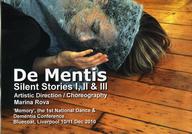 De
Mentis: Silent Stories I, II and III is a research performance project
exploring the lived experience of dementia and a collaboration between
Artistic Director, Choreographer and Dance Movement Psychotherapist
Marina Rova with London-based artists and therapists. This work has
been born out of Marina's witnessing and clinical encounters in a
Continuing Care Unit for Dementia and her curiosity about: the embodied
‘reality’ of the terrifying symptoms of the disease, the
richness and variety of experiences of those living with dementia,
the wisdom of the re-membering body and finally, the generosity of
spirit and immense sense of humour of many of the affected people
she has worked with. De
Mentis: Silent Stories I, II and III is a research performance project
exploring the lived experience of dementia and a collaboration between
Artistic Director, Choreographer and Dance Movement Psychotherapist
Marina Rova with London-based artists and therapists. This work has
been born out of Marina's witnessing and clinical encounters in a
Continuing Care Unit for Dementia and her curiosity about: the embodied
‘reality’ of the terrifying symptoms of the disease, the
richness and variety of experiences of those living with dementia,
the wisdom of the re-membering body and finally, the generosity of
spirit and immense sense of humour of many of the affected people
she has worked with.
In the preliminary stage of the work, and over a series of ten structured
embodiment workshops (May-July 2010), the group unpacked themes arising
from the illness and the care available for it. As a certified Dementia
Care Mapper (Bradford University) Marina incorporated principles of
this approach into a blend of creative process methods such as improvisation,
authentic movement, movement sculpting, free association, vocalisation,
writing, drawing and contact work, among others, whilst maintaining
a phenomenological perspective throughout the investigative process.
The final three-part theatre performance takes the viewer into a journey
of memory, identity and the un-known. The performers' transformative
dance will journey them from dark to light , from joy to dispair...
into the other side of the looking glass and back again...What will
they find on their searchings and how will they emerge from the process?
De Mentis aims to bring the viewer closer to the lived world of dementia.
It does not wish to show what people who experience dementia 'look
like' nor does it give solutions to the problem. By introducing embodied
(lived) stories, inspired by people who have experienced the disease,
De Mentis aims to remove the stigma attached to aging and dementia.
De Mentis celebrates personhood, humanity, life and embodiment. The
final product is a three-part dance theatre performance including
performances by 8 artists and an original music score. The piece will
also be available for installation, presentation and lecture/conference
purposes in Winter 2010.
An excerpt of the final work (up to 4 performers) is available for
a Premiere Showing at the Dance and Aging Symposium in Liverpool (2010).
- Bisakha
Sarker
We Have Known
...is about remembering,
about the journey forward
as much as it is about the
journey taken;
Alongside wisdom
memories dance,
absences can still hold me.
Remembering is what moves me on.
We Have Know was made over three days in autumn 2010 at the University
of Plymouth
- Talking pen
TalkingPEN Publications is an innovative, London-based, publishing house
that develops ground-breaking technologies for a diverse range of markets,
including resources to support teachers and learners. TalkingPEN Publications
is part of Mantra Lingua - the leading international publisher of dual-language
resources for the learning of English. They are the publisher of an
award-winning, unique technology that brings sound to paper.
TALKINGPEN is the breakthrough technology that brings high quality
sound to paper with audio information, songs, stories and games. This
is a low cost solution to many ICT needs and has won numerous awards
in Britain. Make and access recordings instantly, anywhere, with this
wire-free portable pen. Hours of content can be stored on the 2GB
TalkingPEN that is simple to use and affordable.
Some key products include the award-winning Talking Stickers, award-winning
resources for the blind, a unique device for the bird watching market
and exciting projects with large international organisations.
TalkingPEN Publications are keen to establish new links and are happy
to discuss the customisation of bespoke resources to suit your needs.
- Dr
Sarah Whatley with Naama Spitzer
Dance Connections: researching the experience of dance artists and elders
with dementia and memory loss working together
This presentation will reflect on an artist development programme,
led by Dance Art Foundation in association with Coventry University
during 2009, which offered dance activities for elders alongside an
opportunity for dance artists to develop new skills in working with
older people with reduced mobility, memory loss and dementia. The
focus will be on the research process which ran alongside and within
the project. We will discuss the participant observation research
methodology; the value of this method, and what records were generated
and documented to reveal the importance of an embodied engagement
with the process. We will present some of the findings to highlight
how a model of exchange supports all those involved in the project,
resulting in the elders’ experiences being valued as a source
for movement development and the impact on the dance artists’
own professional development.
|
|
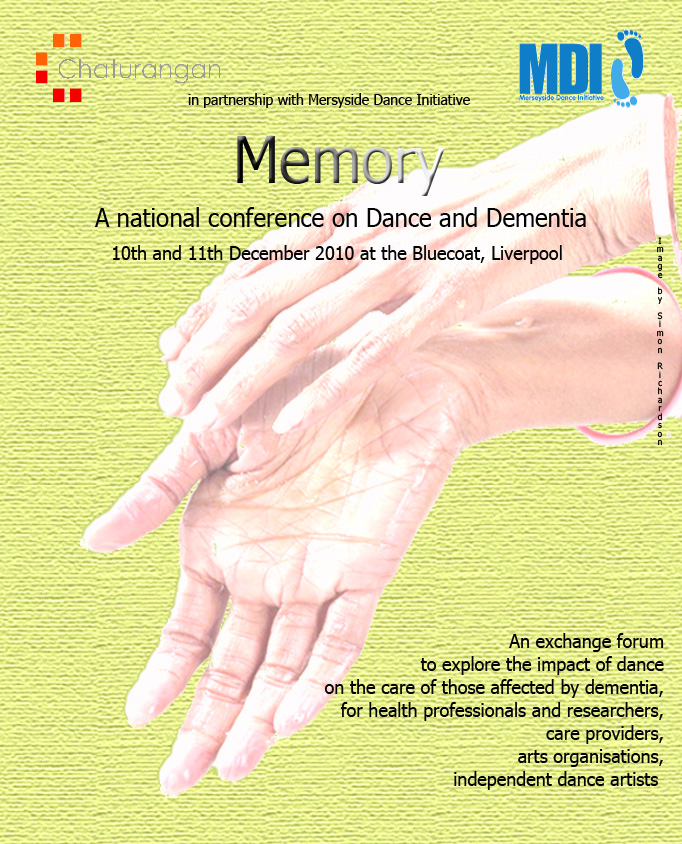

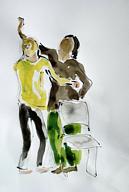
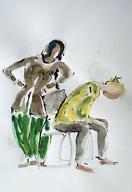
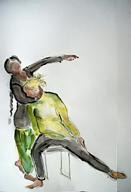
Paintings by
Noelle Williamson
of Bisakha Sarker and Diane Amans rehearsing their piece for this
conference.
|







